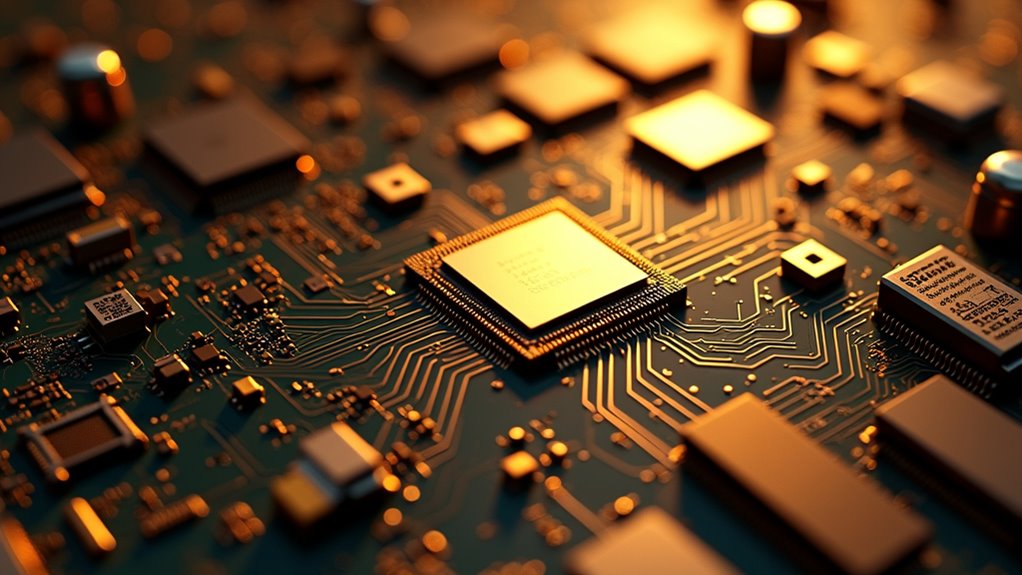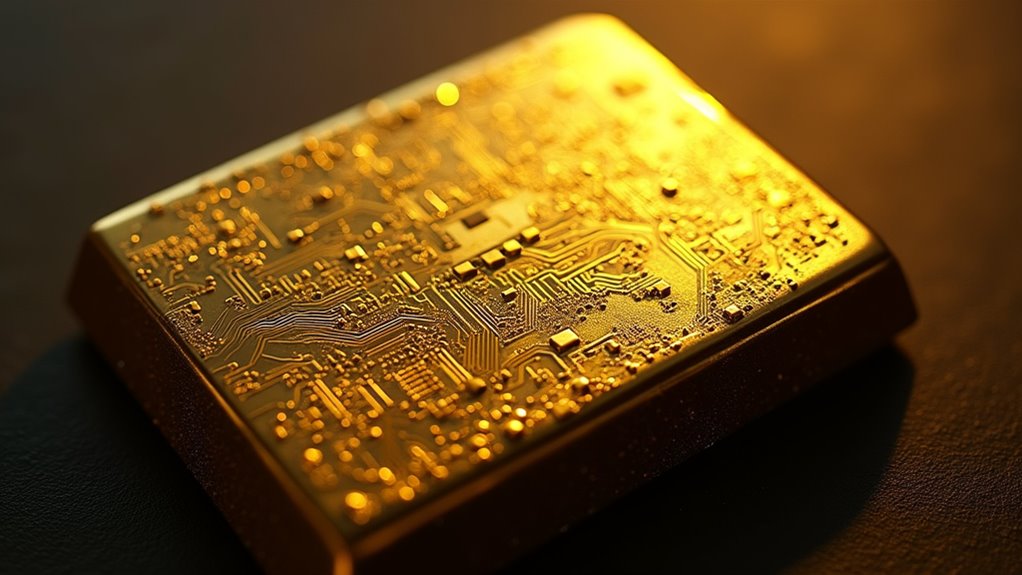Gold’s exceptional properties make it indispensable for AI hardware advancement. Its superior electrical conductivity enables efficient data processing, whilst outstanding thermal properties facilitate heat dissipation in demanding computing environments. The precious metal’s remarkable resistance to corrosion guarantees longevity in mission-critical components, from microcircuits to data centre infrastructure. As AI technology evolves, gold’s unique characteristics continue shaping the future of high-performance computing and machine learning capabilities in fascinating ways.

Three essential properties make gold an irreplaceable component in modern AI hardware: its superior electrical conductivity, exceptional resistance to corrosion, and remarkable durability. These characteristics have positioned gold as a critical material in the advancement of artificial intelligence technologies, particularly in the development of sophisticated hardware components that power AI applications across various industries. Additionally, gold’s role in electronic devices extends beyond mere functionality, as it contributes to the overall reliability of technology. Gold is also favored for its high thermal conductivity, which ensures efficient heat dissipation in high-performance AI systems. Moreover, gold’s vital role in semiconductor manufacturing underscores its importance in the fabrication of reliable microchips.
The metal’s outstanding electrical conductivity enables the efficient processing and transmission of data in AI systems, making it invaluable for microcircuits and connectors. This property allows AI hardware to handle dense electrical currents while minimizing energy loss, facilitating the rapid and accurate processing of substantial datasets that modern AI applications demand. When compared to alternatives like silver, gold’s stability and consistent performance make it the preferred choice for sensitive AI components.
Gold’s unmatched conductivity powers AI systems, enabling efficient data processing while outperforming alternatives for mission-critical hardware components.
In the domain of high-performance computing, gold plays a pivotal role in processors designed for intensive AI applications. The metal’s properties support the efficient computation required for market analytics, predictive modeling, and processing massive datasets in industries such as banking and logistics. Its presence in AI chips enhances both speed and efficiency, contributing to advancements in deep learning frameworks that rely on consistent hardware reliability.
The proliferation of AI-driven devices has further cemented gold’s importance in modern technology. From smartphones to autonomous vehicles, these devices depend on gold-containing sensors and processors for stable, high-speed functionality. The metal’s unique properties enable the miniaturization of AI hardware components without sacrificing performance, while guaranteeing reliable operation in data-heavy, real-time applications that characterize today’s consumer technology landscape.
Data centers, which form the backbone of AI infrastructure, heavily rely on gold to maintain the performance of electronic components such as memory chips and server-grade processors. The metal’s stability under high workloads and its superior thermal properties guarantee uninterrupted operations in data-intensive environments. As AI model training continues to grow more demanding, gold’s role in meeting power and computational efficiency requirements becomes increasingly essential.
The surge in AI adoption has created unprecedented demand for industrial gold, potentially affecting market dynamics and prices. While innovations in gold usage, such as thinner coatings, are being developed to address cost concerns, the metal’s fundamental role in AI hardware remains secure. The combination of gold’s superior conductivity, corrosion resistance, and durability continues to make it an essential component in the advancement of AI technologies, guaranteeing reliable performance in mission-critical applications across healthcare, finance, and other sectors where system failures could have significant consequences. Additionally, the unique properties of gold make it an unmatched choice for electronics, further underscoring its value in AI hardware development.
Frequently Asked Questions
Can Gold-Based AI Hardware Components Be Recycled Effectively?
Gold-based AI hardware components can be recycled with remarkable effectiveness using innovative technologies.
Advanced methods like vinyl-linked covalent organic frameworks achieve 99.9% gold recovery, whilst protein sponges derived from cheese waste can extract gold at 90.8% purity.
AI-enabled microfactories and robotic systems precisely identify and extract gold-containing parts, making the process economically viable when material and energy costs remain below 1/50th of the reclaimed gold’s value.
How Does Gold Compare to Silver in AI Chip Manufacturing?
Gold outperforms silver in AI chip manufacturing due to its superior electrical conductivity and remarkable durability.
While silver offers cost advantages, it’s prone to tarnishing and degradation, particularly in high-temperature applications.
Gold’s resistance to corrosion and environmental stressers makes it invaluable for AI hardware, especially in data centres and autonomous vehicals.
Despite its higher cost, gold remains the prefered choice for advanced AI components where reliability is paramount.
What Safety Measures Are Required When Handling Gold in AI Hardware Production?
When handling gold in AI hardware production, strict safety protocols are critical. Workers must utilise cleanroom environments and wear appropriate PPE, including gloves and masks, to prevent exposure to gold nanoparticles.
Regular air quality monitoring helps protect against airborne gold dust, while automated systems minimise direct human contact.
Secure storage facilities and proper waste management procedures guarantee both worker safety and material security throughout the manufacturing process.
Does the Geographical Source of Gold Affect AI Hardware Performance?
The geographical source of gold has no impact on AI hardware performance.
Gold’s physical and electrical properties remain identical regardless of where it is mined, ensuring consistent conductivity and reliability across all hardware applications.
While sourcing locations may affect production costs and supply chain ethics, the actual performance of gold-based components in AI systems remains unchanged.
The only variations relate to economic and logistical factors, not technical capabilities.
How Will Future Gold Price Fluctuations Impact AI Hardware Development Costs?
Future gold price fluctuations will greatly influence AI hardware development costs, with rising prices potentially increasing manufacturing expenses by 15-25%.
Companies may need to adjust their R&D budgets and production schedules accordingly.
While some manufacturers are exploring gold-thrifting technologies and alternative materials, these solutions often compromise performance.
The market’s sensitivity to gold prices could slow innovation cycles and affect the affordability of next-generation AI hardware solutions.












